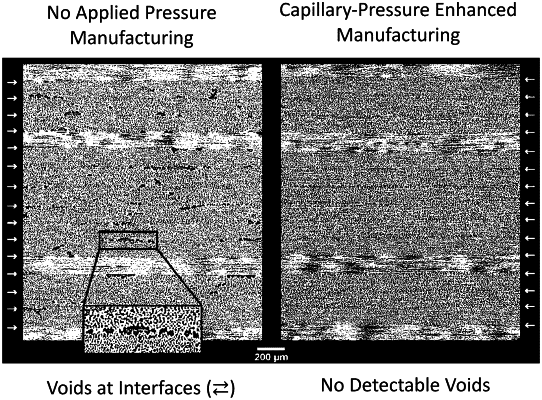| CPC B32B 37/18 (2013.01) [B32B 5/02 (2013.01); B32B 5/024 (2013.01); B32B 5/24 (2013.01); B32B 37/06 (2013.01); B32B 37/1018 (2013.01); B32B 2260/023 (2013.01); B32B 2260/046 (2013.01); B32B 2262/0261 (2013.01); B32B 2305/026 (2013.01); B32B 2305/076 (2013.01); B32B 2305/10 (2013.01); B32B 2309/105 (2013.01); B32B 2309/68 (2013.01)] | 25 Claims |

|
1. A multiscale composite material stack-up comprising:
one or more planar fibrous layers comprising micron scale fibers that are substantially continuous and aligned in a single unidirectional arrangement or a multidirectional planar weave;
one or more planar porous layers with a porosity of no less than 50% that are thinner than the one or more planar fibrous layers, the one or more planar porous layers formed by nanoscale electrospun polymer fibers, and a distribution of structural elements and pore regions within the nanoscale electrospun polymer fiber layers, wherein the pore regions are defined by spaces between the structural elements, and a geometry and the distribution of the structural elements results in the pore regions having a regular pore size distribution,
wherein the structural elements take the form of one or more of fibers, tubes, gels, foams or lattices, and the structural elements comprise organic polymers made from carbon, nitrogen, boron, and oxygen and include a covalent organic network, or inorganic network of silicon, oxide, nitride or carbide compounds and metals, or a combination of the covalent organic network and the inorganic network comprising a polymer-reinforced inorganic structure, and the structural elements are made by growing, printing, molding, forming, depositing, electrospinning, etching or solvent evaporation, and
a polymer matrix that penetrates and binds the one or more planar fibrous layers and the one or more planar porous layers during a curing, forming or heat treatment process;
wherein the geometry and the distribution of the structural elements and the regular pore size distribution of the pore regions of the one or more planar porous layers are configured to:
promote capillary pressure and infusion of the polymer matrix through the one or more planar porous layers, and
reduce void content of the multiscale composite material stack-up after the polymer matrix penetrates through the one or more fibrous layers.
|